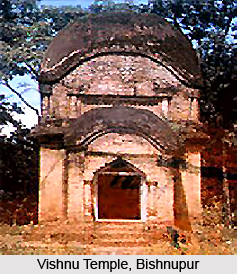 History of Bishnupur dates back to 1467 A.D., when Kyamba had occupied the throne of Manipur by conquering the kingdom of Kyang. According to historical records, the initial name of Bishnupur was Lumlangdon, which is currently known as `Lamangdong`. Kyang was known to be a Shan kingdom which is located in the Kabow Valley of Manipur. When Kyamba ruled Manipur, the relationship between Pong King Khe-Khomba was cordial since the efficient foreign policy of Kyamba enabled his kingdom to be in the good books of his neighbouring kingdoms.
History of Bishnupur dates back to 1467 A.D., when Kyamba had occupied the throne of Manipur by conquering the kingdom of Kyang. According to historical records, the initial name of Bishnupur was Lumlangdon, which is currently known as `Lamangdong`. Kyang was known to be a Shan kingdom which is located in the Kabow Valley of Manipur. When Kyamba ruled Manipur, the relationship between Pong King Khe-Khomba was cordial since the efficient foreign policy of Kyamba enabled his kingdom to be in the good books of his neighbouring kingdoms.
Kyamba had attacked the land of Kyang, accompanied by the king of Pong named Chaopha Khe Khomba. Following his victory, Kyamba and Khe Khomba divided the conquered regions amongst themselves, after dining with each other in golden vessels and golden joins. It is also believed that they exchanged their own scholars and servants. King Khe Khomba, the Pong king had also presented Kyamba a guava or `hei` ton and a certain kind of `dal` known as `Ponghawai`. Besides these gifts, an image of Lord Vishnu was also gifted to Kyamba. Kyamba had placed this holy image at a region which was referred to as Lumlangdong, which thereafter came to be termed as `Bishnupur`, or the abode or kingdom of Lord Vishnu. Probably, the regime of Kyamba witnessed the worship of Lord Vishnu in the Indian state of Manipur. King Kyamba was served by a Brahmin, who helped him worship Lord Vishnu in the region of Bishnupur. The Vishnu Temple, which was made of brick, was constructed by this ruler. Presently, this Vishnu Temple has been granted the status of a protected monument by the Ministry of H.R.D (Archaeology), Government of India.
When King Bheigyanchandra ruled Manipur, it is stated that he had once dreamt of Lord Krishna, who had instructed him to find his image. King Bheigyanchandra took it as a divine command and therefore founded the state of Govindagee. This had occurred in about 1780 A.D. Besides this statue of Lord Krishna, six other idols were also created from the same jackfruit tree. In the year 1973 A.D., the statue of Abdeitya was installed in the Vishnu Temple located in Bishnupur. Innumerable pilgrims and devotees visit this temple.



















